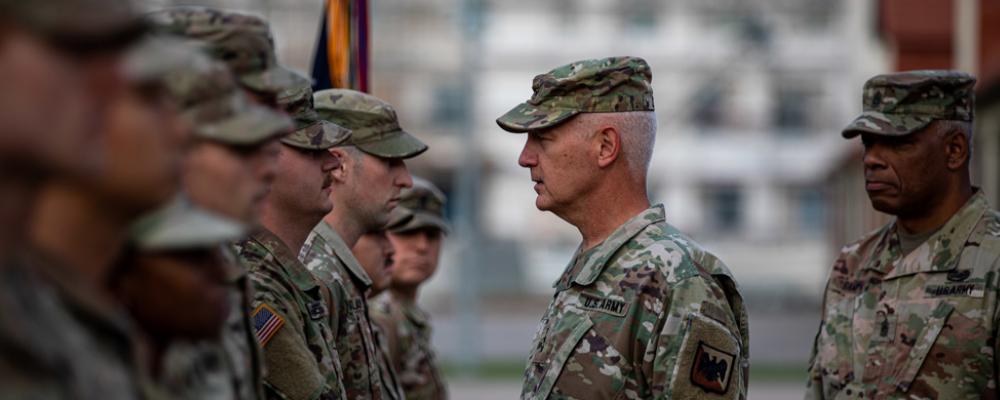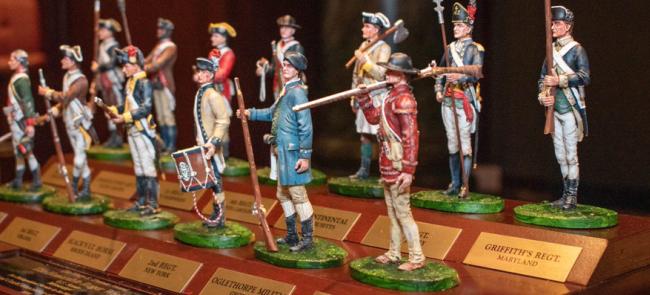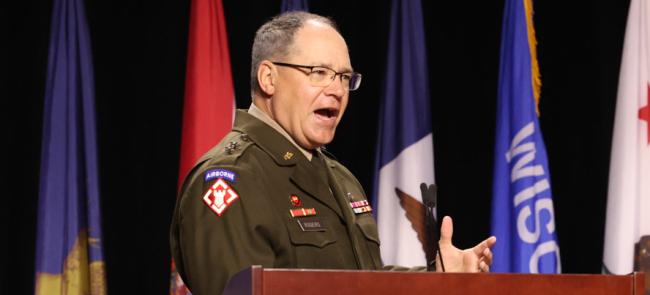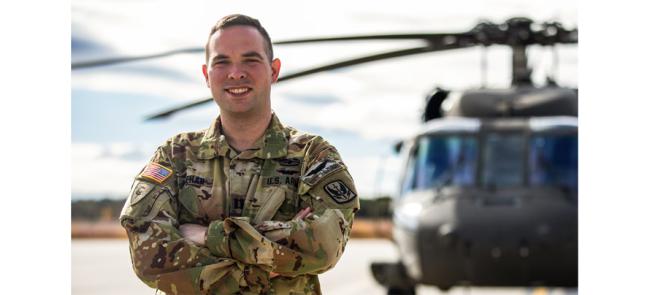
A Conversation with Lt. Gen. Jon A. Jensen
Lt. Gen Jon A. Jensen strongly believes the Army National Guard must adapt to meet the threats of an increasingly dangerous world.
Entering his fourth year in charge of the development and implementation of federal programs and policies affecting the Army Guard, he believes the readiness models of the last two decades are outdated.
Jensen thinks Army Guard units can no longer just time the building of readiness to their next deployment and then take years to rebuild readiness when they return home. He calls that “transactional readiness.”
Today, he says, Army Guard units need to build and sustain readiness, because in today’s world, you never know when you’re going to need it.
Jensen sat down with National Guard last month in his office at the Herbert R. Temple Jr. Readiness Center in Arlington, Virginia. The conversation covered readiness, modernization, improvements in recruiting and the Army Guard’s comparatively low level of full -time manning.
Figures released in June indicate that Army National Guard recruiting is running well ahead of last year. To what do you attribute the increase?
We’re running about 19% better than we were last year, which equates to about 4,000 soldiers right now year to date ahead of last year. We’re on the path to meet our 2023 accession mission. What I attribute that to is the grassroots community-based recruiting. Our recruiters are back in their communities. They’re able to go to those natural locations in their communities where young men and young women gather.
We talk a lot about different generations being influenced by different things. At the end of the day, my belief is that recruiting is still a relationship-based endeavor, and that trust is part of that. And you can only develop that one-on-one face to face with the applicant, and whomever their centers of influence are, whether that’s parents, a teacher or counselor or somebody like that. So, I think it’s just our ability to get back in the community and get face to face with young men and women.
You mentioned generations. Generation Z, people born between 1997 and 2012, is now the military’s target audience. What are you learning about how to communicate with Gen Z, and its propensity to serve?
I believe they have a strong propensity to serve. I just look at my kids who fall in that category and their community-service projects that they’ve worked on as people. I believe there is a propensity to serve in this generation. What we must do is convince this generation that part of that service can be with the Army National Guard.
Again, it gets back to that relationship-building. Now, the difference with the current generation is just that initial contact. How do you make that initial contact? And it’s based on a digital connection. Whether that is social media, applications on phones, it’s no longer what I grew up with cold calling. You used to sit near a phone and you start calling people on the phone. That initial connection like that doesn’t really exist anymore.
Because members of Gen Z don’t pick up the phone?
That’s right. They don’t answer their phone. Their phone, it’s not a phone; it’s a computer. A different approach than our generation.
The National Defense Strategy calls for 16-plus Army divisions, capable of performing multiple domain operations. The active component has 10 divisions. The Army National Guard must provide the rest. Unfortunately, Guard divisions lack some of the capabilities of active divisions. One example is the MQ-1C Gray Eagle, the UAS that can be used to better target long-range artillery. What does the Army have to do to close these capability gaps so Army Guard divisions can fulfill their NDS requirements?
I think this is part of the Total Army modernization plan as we move to two critical benchmarks in the future: the Army of 2030 and then the Army of 2040. And we’re part of that modernization effort. So, when we say divisions, what we’re really talking about are the brigades and below that form the division, but also, as you mentioned, those division enablers that allow the division to really shape the battlefield for our brigades to be successful. So, I’m confident of where we are in the Army’s modernization plan.
You mentioned the Gray Eagle. We know that there’s a UAS after Gray Eagle. So, the question becomes, do we invest in older technology today? Or do we wait and invest in newer technology out on the horizon? So, that’s the balance that we’re in right now. And it’ll be a combination of both, I think. But we can see where we’re going to grow field artillery capability. We believe we’re going to grow air defense capability. These are two critical areas for the Army that we know that the Total Army, when you look at all three components, is short of right now, as we look at multidomain operations and large-scale combat operations.
Are you confident that the Army National Guard, in the years ahead, will mirror the active component divisions?
So, what I’ve talked to the Army about is, as we look at the Army, pre-9/11, not all of our formations looked exactly alike. I’ll give you an example: We had the enhanced brigades in the Army Guard that were brigades that were commanded by brigadier generals. Compo One didn’t have that, but we had that. And then after 9/11, we went into this modularity phase of the Army where everything was supposed to look exactly the same.
By and large, brigades will mirror each other across components. But over time, there’s going to be some opportunity to assess if we need to look a little bit different. For example, our infantry brigade combat teams. There very well can be three different types of infantry brigade combat teams, across the whole Army. What I’ve said to the Army is, it’s OK that we don’t look exactly alike, because even inside of the active-component Army, they’re not going to look exactly alike either. So, I think we’re going back to an Army maybe that was pre-9/11, where we create a little bit different capabilities in different formations.
In June, the Army unveiled the M-10 Booker, the military assault vehicle named after two fallen heroes, including one from the 34th Infantry Division, who fought and died In World War II in Tunisia. It looks like a tank and it’s meant to give light infantry units a little more firepower. Is the Army National Guard in the fielding plans for the M-10 Booker?
Yes, we are. Right now, we’re currently scheduled to receive two battalions with that capability.
It’s intended to give light infantry-formations that extra punch in urban terrain. So, if you think of combat in large cities, for example, this is going to help that light infantrymen gain overmatch inside of those urban environments. So yes, we are currently programmed to receive that weapons platform.
Heel-to-toe deployments to Iraq and Afghanistan are over, but the Army National Guard remains busy overseas. The Guard took over many missions to free up the Army during the height of conflicts in Iraq and Afghanistan. Why does the Army Guard still perform these missions?
The secretary of the Army tasked us to do it, so we do it. All those missions you laid out, it’s heel to toe, right? So, OSS [Operation Spartan Shield] in Southwest Asia, Guard division after Guard division after Guard division. Most of the brigade deployments there are also Army Guard brigades. MFOs [Multinational Force and Observers on the Sinai Peninsula] belong to the National Guard for quite a while. OHOA [Operation Horn of Africa] has been an Army Guard battalion for quite a while.
But really, three reasons. One, the size of the active-component Army is too small to meet all the demands that the Army is being asked to do. So, we help fill that gap, as does the Army Reserve. Two, under ReARMM [the Aligned Readiness and Modernization Model], we’re going through these modernization phases inside of the Army. We all have to take time away from training and deployments, so we can go through that modernization phase. There are fewer Army units to meet the demands. And I think most importantly, the third reason is our soldiers want to deploy. Our soldiers want to be a part of something bigger and be a part of the deployment experience. And units became more capable from the full deployment experience — preparing for a deployment, deploying and then coming back.
Perhaps even more cohesive.
Yes, absolutely. So, at the end of the day, when I look at my 40-year career, the Army National Guard in 1982, and the Army Guard in 2023, we are significantly more capable, in part, because of these deployment experiences our soldiers and our units have had.
No Army Guard officer or NCO still expects to serve just 39 days a year. Is it a part of your job to remind Army leaders sometimes that the Guard is still a part-time job?
Absolutely. And it’s all Army leadership, not just headquarters Department of the Army, but also inside the Army National Guard. We have to remember our traditional Guardsmen have an expectation that we can be predictable, meaning that they can see out onto the horizon and know what the requirements are going to be for them. And that we only use them when we have to use them, that we’re not volunteering them up to do things.
The friction kind of becomes that we see overseas deployments as ensuring our relevancy, and we want to be a relevant force. So, to be a relevant force, we believe we need to be utilized. It gets to that balance about the domestic mission and the federal mission. How do we do that while simultaneously maintaining our ability to have traditional Guardsmen serve at the highest level of our force?
It’s challenging, but I look back on the last time I deployed in 2009. Our mobilization load was 70,000 Guardsmen a year. Now in 2023, it’s about 20,000 Guardsmen. So, we’ve seen a significant decrease, but at 20,000, I think it still provides us enough opportunity where we can get all those benefits associated with employing and deploying the force. I’m very concerned about our ability to create contingency-based readiness, that no-notice, short-notice employment.
In 1993, the leaders of the Army’s three components met in locations outside the Pentagon to determine what the future holds for the Army National Guard, and the Army Reserve. The so-called Offside Agreement called for the Army Guard to focus on its historic combat role, while the Army Reserve would handle combat service support. A lot has happened in the last 30 years, but many of our former Army Guard leaders believe the agreement is as valid today as it was in 1993. What’s your take?
I absolutely believe it’s as valid today as it was in 1993. During August of last year, I hosted some brand-new Army Guard general officers. Retired Gen. Frank Grass, a former chief of the National Guard Bureau, was our senior mentor. And I asked the group of new generals about the 1993 Offsite and what did they know about it. And I was amazed that not one of them could talk about the 1993 Offsite. They said that they’d heard about it, but they didn’t really know it.
That really kind of put me on a path that we had to reeducate the senior leaders of the Army National Guard about that key document. Because that key document establishes roles that establishes capabilities in both the Army Guard and the Army Reserve. And we need to understand why that document was needed. We need to understand what that document says, because it’s the cornerstone document in how we’re organized as an Army National Guard and what our contribution is to the Army.
It’s worked well the last three decades.
Absolutely. And so when I get with new generals, I always talk about the 1993 Offsite, and I give them a copy of the agreement. I tell them that they need to understand it because that is not only who we were to become, but that’s who we are going to remain to be into the future. Specifically, we’re going to be the combat-arms reserve of the Army.
I know you go out and visit Army National Guard soldiers and units. What are our commanders and soldiers sharing with you about the force and its utilization?
I think it’s, again, this idea that they want to be deployed. They want to contribute. They are seeking predictability though, as we continue to go through mobilizations inside the Army Guard. We’ve come to where it’s become predictable. Some of the timings of immobilization orders, there’s concern about that.
We want to ensure that we can publish mobilization orders at the 180-day mark, so those soldiers can fully prepare themselves and their family for deployments. When we don’t meet that 180-day mark and it starts sliding inside of, for example, 90 days, it causes a lot of additional friction to our soldiers and their families that, quite frankly, they don’t deserve. I would say those things. Predictability, more timely mobilization orders and this desire that they want to continue to deploy.
You were both a division commander plus the adjutant general in Minnesota. How often do you rely on your memories, your experiences, from your desk here?
There’s an old saying about general officers that the problems they tried to solve are those they came across when they were lieutenants. So, I think our experiences shape all of us. I think being an adjutant general really prepared me for this position, in the sense that it really showed me the criticality of communication from this office to our adjutants general, and how that has to remain consistent and transparent.
You have to create a system where our adjutants general have the ability to inform and influence decisions here in the building in a way that we can all see how that works. A lot of what I do here was informed as my time as an adjutant general and as a chief of staff to a TAG. I was chief of staff to a TAG for about six and a half years. When you add that time with my time as the TAG, I’ve watched this enterprise for about nine years. And so coming in, I knew there are some things that really worked well, and there were some things that we need to avoid.
NGAUS is hearing that promotion timelines are getting longer and there are longer wait times for federal recognition of the state promotions. What are you seeing?
I think that was a great question last year. It’s an even better question this year because it’s becoming shorter. We’re down to 103 days, for O-5 and below. So, we figure, in a perfect world, once we receive the unit vacancy promotion request, it takes us about 30 days in the building, and then it goes over to the Army and takes about 90 days there. So really, we believe 120 days is kind of the mark that when we hit 120 days or less, we’re at success. Right now, for 0-5 and below, it’s 103 days. At the O-6 level, what we’re seeing is about 153 days right now.
We did a process improvement here. We reduced it from 18 steps down to three. We now do two scrolls a month, whereas previously we were only doing one scroll a month. We think we’ve got the process down. Now, what we need to do is just regain the confidence of the field. We fixed the problems, and the new mark of less than 120 days is something that we can sustain.
The perception is it’s still a paper process in 2023.
Part of the process improvement was to automate as much of this as we could so it wasn’t so reliant on what we think of when we think of literally a packet. The packet is built electronically, and it moves that way.
The Army National Guard has the lowest percentage of full-time manning in all of the reserve components. Why is that and what will it take to increase full-time manning in the Army National Guard?
I can’t answer why it is, because it’s always been that way it feels like my whole career. So, I don’t know how we got here. What is it going to take? I think it’s going to take the support of the Army headquarters department and it’s going to take the support of Congress to do that. HQDA is going to have to ask for additional funding to man the full-time force and Congress is going to have to give the money to the Army so we can increase our full-time force. Without both of those entities agreeing to that and supporting that, I think we’re going be stuck in the same situation we’re in.
Do you feel as if the Army is looking at the Guard and saying you meet all these requirements, so we really don’t need to give you any more full-time personnel?
There is a belief that maybe part of our challenge is that we create the readiness that the Army needs, so maybe they don’t see like they need to invest.
Victims of your own success?
Maybe yes, that could be it. Our full-time manning program is based on a pre-9/11 model when we didn’t have a lot of readiness requirements. We used the term strategic reserve. We had this belief that we’d have all this time to create readiness. Then the Global War on Terrorism came and we saw this huge demand for the Army. So, we took a preexisting full-time manning model and we augmented it temporarily with ADOS [Active Duty for Operational Support] money primarily funded through OCO [Overseas Contingency Operation account] to help us create that readiness during that time.
We’ve lost that funding, but we still have a much higher readiness requirement in the Army Guard than what we did pre-9/11. But with all that ADOS money now gone, we don’t have the full-time manning to really support the higher-level readiness we’re expected to achieve. So, the readiness requirements have changed. Now, we need to make sure that the full-time manning requirements change to help us meet those readiness requirements. We are very good at pre-planned mobilizations. The “gift map” is what we call it; you can see that on the horizon. I’m very concerned about our ability to create contingency-based readiness, that no-notice, short-notice employment.
So, I think there’s two approaches to that we must follow. The first is the full-time manning model. The second piece, and it’s something that we’re really trying to educate and bring junior leaders around on, is generational readiness, that we need to create and maintain levels of readiness, whereas previously, our readiness was really tied to a scheduled deployment.
You got ready for deployment, you deployed, you came home and nobody cared what your readiness level was because you didn’t have to be ready until your next deployment. I call that transactional readiness. We created it, we spent it and then we ignored it. And then when you needed it again, we’d create it, we’d spend it and we ignored it.
What we need today is generational readiness. We need to build readiness and sustain it, because now we don’t know when we’re going to need it, whereas previously it was all tied to a scheduled deployment.
This is your first assignment in Washington. What have you learned over the last three years about the Pentagon and the way things work in the nation’s capital?
One, it’s all about relationships. The great thing in this job is I get to see the whole Army. As the director of the Army Guard, whether it’s the generating force, the operating force or the institutional base in the Army, the Army Guard in all three of those. Two, I think that deep respect that the Army Guard has earned inside of the Army. Every senior Army commander I talked to wants to share their experience with the Army Guard that they’ve had in their career, and how impressed they are with our units and our soldiers.
And maybe on a bit lighter note, those things that you ignore as a major, come back to haunt you when you’re a lieutenant general. And for that, I would say, at the state level, you exist really as it relates to PPBE, the planning, programming, budgeting and execution process, on the E, the execution piece. Here, it’s all about those three letters to the left. And I had to do a lot of fast learning when I first came up here because prior to this, all my experience just been on the execution piece.
AT A GLANCE: Lt. Gen. Jon A. Jensen
BORN: Jon A. Jensen, 1963 (Council Bluffs, Iowa)
FAMILY: Wife (Cindy), three children
EDUCATION: Northwest Missouri State University, Maryville, Mo., B.S. Finance and Business Economics, 1986; U.S. Army Command and General Staff College, Fort Leavenworth, Kan., M.A. Military Arts and Sciences; U.S. Army War College, Carlisle, Pa., M.A. Strategic Studies
COMMISSIONING SOURCE: Officer Candidate School
MILITARY SERVICE: Iowa Army National Guard, 1982- 2002; Minnesota Army National Guard, 2002-present
PREVIOUS ASSIGNMENTS: Adjutant General of Minnesota, St. Paul., Minn., 2017-2020; Commanding General, 34th Infantry Division, St. Paul, Minn., and (dual-hatted) Deputy Commander and Army Reserve Component Integration Advisor, U.S. Army Africa and Southern European Task Force, U.S. Africa Command, Vicenza, Italy, 2017; Commander, 1st Armored Brigade Combat Team, 34th Infantry Division, Bloomington, Minn., 2012-2014
OVERSEAS OPERATIONS: Desert Spring (Kuwait), Joint Forge (Bosnia-Herzegovina) and Iraqi Freedom (twice)
ALSO NOTABLE: Began military career as an enlisted combat medic, advancing to staff sergeant before attending OCS in 1989. Served on the NGAUS board of directors as the TAG representative for Area V from 2019 until taking over as Army Guard director in 2020.
Source: National Guard Bureau



